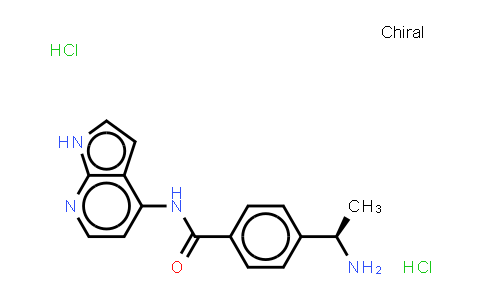| Chemical Name |
Y-33075 (dihydrochloride) |
| CAS Number |
173897-44-4 |
| MDL Number |
MFCD00945328 |
| Molecular Formula |
C16H18Cl2N4O |
| Molecular Weight |
353.25 |
Introduction of 173897-44-4 :
Y-33075 dihydrochloride is a selective ROCK inhibitor with an IC50 of 3.6 nM. IC50 & Target: IC50: 3.6 nM (ROCK), 420 nM (PKC), 810 nM (CaMKII)[1] In Vitro: Y-33075 (Y-39983) is a potent ROCK inhibitor, with an IC50 of 3.6 nM. Y-33075 also inhibits PKC and CaMKII more potently than Y-27632, and the IC50s of Y-27632 and Y-33075 for PKC are 9.0 μM and 0.42 μM, respectively, whereas the IC50s of Y-27632 and Y-33075 for CaMKII are 26 μM and 0.81 μM, respectively. The IC50s of Y-27632 and Y-33075 for PKC is 82 and 117 times those for ROCK, respectively, whereas the IC50s of Y-27632 and Y-33075 for CaMKII is 236 and 225 times those for ROCK, respectively[1]. Y-33075 (Y-39983, 10 μM) extends neurites in the retinal ganglion cells (RGCs) compared with those in RGCs treated without Y-39983[2]. Y-33075 (Y-39983, 1 μM) inhibits the contraction of rabbit ciliary artery segments evoked by histamine in Ca2+-free solutions. Y-33075 (10 μM) shows no effect on the [Ca2+]i increase with the high-potassium (high-K) solution[3]. In Vivo: In rabbits, Y-39983 (≥0.01%) significantly lowers intraocular pressure (IOP) at 2 hours after topical administration. In monkeys, Y-39983 (0.05%)-treated eyes show significant reduction of IOP between 2 and 7 hours after topical administration[1]. Y-39983 (100 μM) increases the regenerating axons of retinal ganglion cells (RGCs) in the eyes of the rats[2].
| Purity |
NLT 98% |
| Storage |
at 20ºC 2 years |
*The above information is for reference only.
